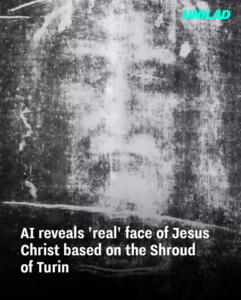In a remarkable fusion of ancient history and modern technology, artificial intelligence has been employed to generate a lifelike image of Jesus Christ, based on the Shroud of Turin—a revered relic believed by many to be the burial cloth of Jesus. This AI-generated depiction has ignited widespread interest and debate across social media platforms.
The Shroud of Turin is a 14-foot linen cloth bearing the faint image of a man, complete with markings that suggest crucifixion wounds. Housed in the Cathedral of St. John the Baptist in Turin, Italy, the shroud has been a subject of fascination and controversy for centuries. While carbon dating in 1988 suggested a medieval origin, more recent analyses using X-ray technology propose that the shroud could date back approximately 2,000 years, aligning with the time of Jesus Christ
Utilizing AI tools like Midjourney and Gencraft, researchers processed images of the shroud to create a realistic portrayal of the man it depicts. The resulting image shows a figure with shoulder-length hair, a beard, and facial features consistent with traditional representations of Jesus. Notably, the depiction includes visible wounds, reinforcing the association with crucifixion .
A video featuring this AI-generated image has gone viral, showing the figure blinking, smiling, and praying. However, the portrayal has sparked criticism, particularly regarding its accuracy in representing Jesus’s likely Middle Eastern appearance. Experts like Dr. Meredith Warren have pointed out that the depiction appears too Caucasian, which contradicts historical and geographical context .
Despite the debates, the AI-generated image offers a compelling in tersection of faith, history, and technology. It provides a visual interpretation that, while not definitive, invites reflection on the life and legacy of one of history’s most influential figures.
tersection of faith, history, and technology. It provides a visual interpretation that, while not definitive, invites reflection on the life and legacy of one of history’s most influential figures.
The Shroud of Turin continues to be a focal point for both scientific inquiry and religious devotion. As technology advances, it may offer new avenues for exploring and understanding this enigmatic artifact and the person it is believed to represent.
